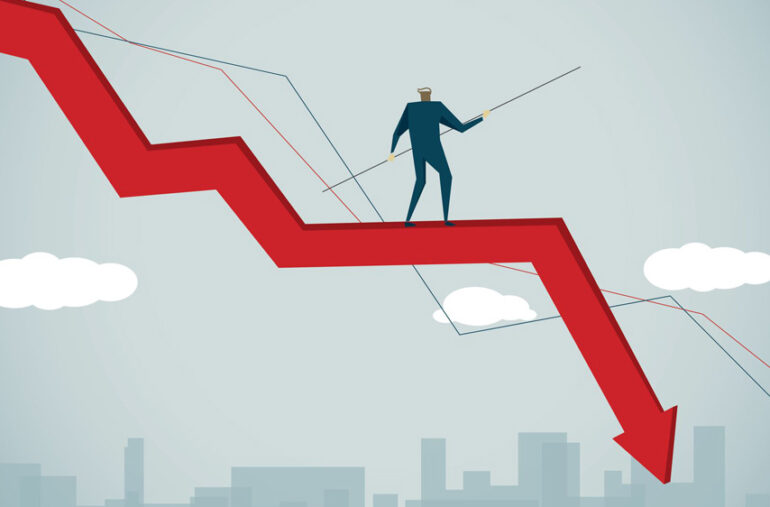
Private Consumption Dropped, India Markets May Let Off Excess Valuations
BY

Dr.V.V.L.N. Sastry
Jurist & Financial Economist
[Sassy_Social_Share]
According to the Indian National Statistical Office, the Indian economy expanded by 8.41% in the second quarter of the fiscal year 2021-22 (FY22) compared to the corresponding quarter in 2020-21. However, following the economy’s 20 percent expansion in the first quarter of this fiscal, can the 8 percent growth in the second quarter be seen as evidence that India is returning to growth after the pandemic-induced slowdown
It is hardly surprising to see this scenario since the mainstay of G.D.P. has remained depressed throughout this recovery period, namely private final consumption expenditure (P.F.C.E.). The P.F.C.E. has generally been above 55 percent of G.D.P. in good times, but in recent quarters, the share has struggled to remain above this mark and fell below it in the second quarter of FY22. Furthermore, in absolute terms, P.F.C.E. declined continuously between the third quarter of 2018-19, before recovering in the second half of the previous financial year. As a result, the recovery in P.F.C.E. was not sustained, which impacted the economy’s performance as a whole.
P.F.C.E.’s recent trends indicate that the labor market is still depressed following the unprecedented shocks caused by the lockdown following the pandemic. According to the Centre for Monitoring Indian Economy, although the unemployment rate decreased during the second quarter of FY22, the labor force participation rate did not quite recover from the depths it had fallen during COVID-19.
Society of Indian Automobile Manufacturers (SIAM) reported that wholesale passenger vehicle numbers in India fell 18.60% year-on-year (YoY) in November due to a shortage of semiconductors. Last month, passenger vehicle sales totaled 215,626 units, down from 264,898 units a year ago.
India’s capital markets continue to experience whipsaws as the broader mood continues to remain ‘Sell on Rise’ with Bears counteracting the Bulls on every significant upward movement. After the conclusion of the Monetary Policy Committee (M.P.C.) meeting on 8 December 2021, the R.B.I. maintained its accommodative stance while keeping the policy repo rate unchanged. The policy repo rate remained at 4%. The reverse repo rate is 3.35%. At 4.25%, the Marginal Standing Facility rate (M.S.F.) remained unchanged. The M.P.C. stated that policy would remain “accommodative” until there is sustained economic growth. R.B.I. maintained the G.D.P. growth forecast for FY22 at 9.5%. It held the C.P.I. inflation projection at 5.3% for 2021-22.
The R.B.I.’s Monetary Policy Committee meeting helped lift the markets’ mood as the policy was more dovish than anticipated. However, M.P.C.’s approach appears to have a more considerable bias towards growth drivers and underestimate inflation, as it reduced the inflation forecasts for Q4FY22 and Q1FY23 to 5.7% and 5%, respectively. At the same time, the U.S. Federal Reserve is considering retiring the term ‘transitory,’ indicating that inflation is here to stay. Indeed, some countries have already raised interest rates, such as New Zealand and South Korea. Russia and Great Britain are likely to follow suit as several central banks increasingly recognize inflation as a critical risk and are announcing policies to contain it. India still looks to be a backbencher on this front and may set a roadmap for future rate hikes based on future policies.
However, why is the R.B.I. still biased towards growth and not seeing high inflation trends? This is because the recovery has been uneven. Although the G.D.P. numbers seem encouraging, private consumption, accounting for 60% of our G.D.P., remains 3% below pre-pandemic levels. The unorganized sector is still suffering from pandemic blues and is under-represented in the G.D.P. numbers. The FMCG sector’s post-earnings management commentaries stressed that rural demand is declining. Although G.D.P. numbers are mildly above pre-pandemic levels, our growth is far behind what it would have been had the pandemic not happened. Taking into account these factors, as well as the potential threat posed by Omicron, it appears that M.P.C.’s best option at this time is to continue supporting the broader economy. However, only time will tell how long inflation can be put on hold in the R.B.I.’s strategy.
After witnessing a bounce from the demand zone around 17,000, the Nifty 50 closed positive for the second week. Currently, the index is trading around its 20 D.M.A. and facing resistance around 17,550. Moreover, in the last two trading sessions of the week, Nifty 50 continued to trade below the significant rising trend line. In a similar vein, Bank Nifty is also struggling to surpass its resistance at 37,440. In the near term, all of these indicators indicate limited upside.
Indian benchmark indices will be dominated by domestic inflation and the F.O.M.C. meeting. The R.B.I. did not provide any guidance on the rate hike calendar so that all eyes will be on the F.O.M.C.’s stance on tapering and interest rate hikes. It is widely expected that the F.E.D. would consider Omicron’s intensity before aggressively preparing tapering plans, but any surprises can cause jerky movements. Therefore, investors should remain cautious and consider value investing until markets have let off steam from excess valuations.
(The author holds a post-doctoral degree in economics and a doctorate in law and public policy. A passionate economist and law expert.)


